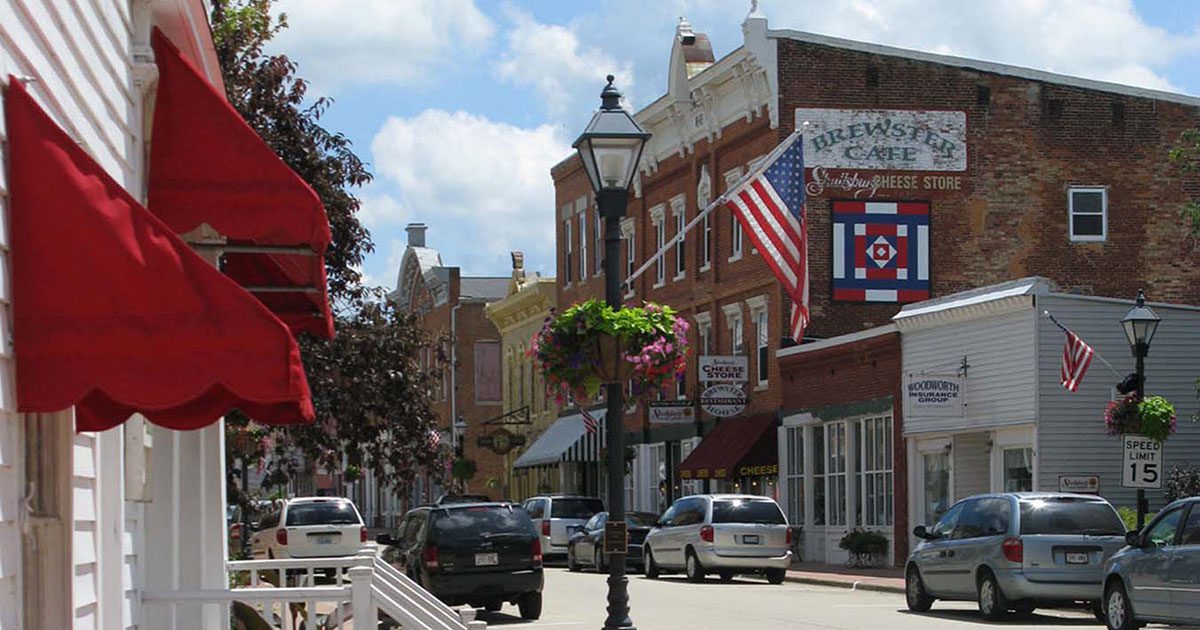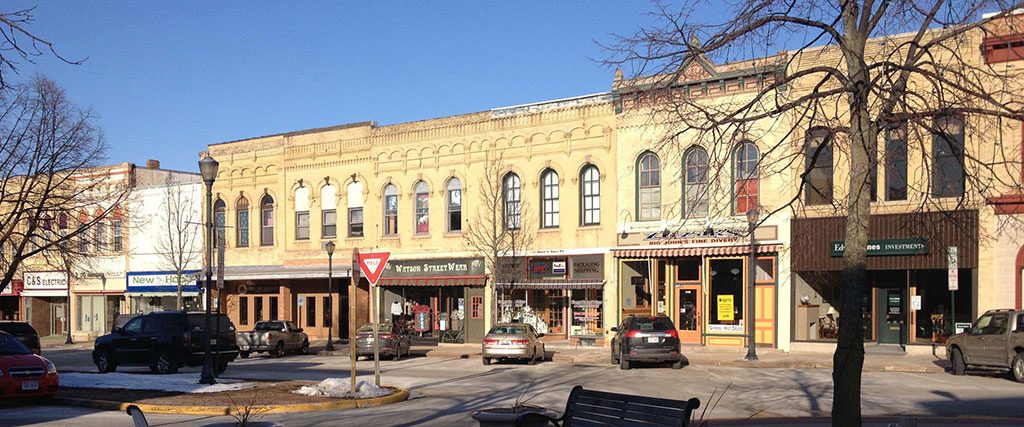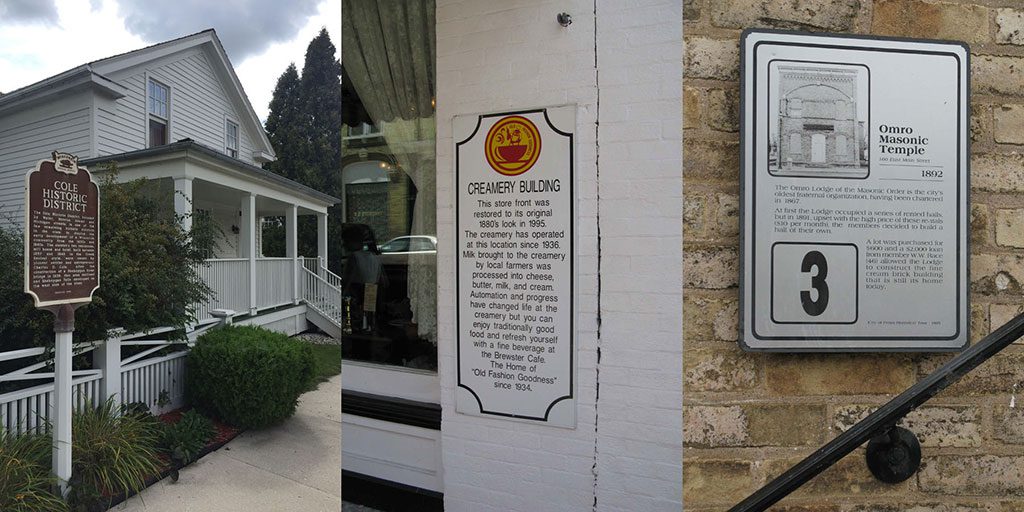
The downtown historic district in Shullsburg bustles with activity.
By Joe Lawniczak, Wisconsin Main Street
February 2023
There are several tried-and-true economic and community development tools for downtown and neighborhood revitalization. One that can be effective and sometimes even vital to such efforts is historic designation. Having properties officially listed as historic can afford local, state, and federal protections and incentives for their maintenance, repair, renovation, or restoration. Although the mention of historic designation sometimes elicits negative connotations, these are largely based on myths, misinformation, and misconceptions.
My wife and I live in a historic district. One day, a real estate agent was showing the house next door to potential buyers. We overheard her telling them it was on the national register, so they would have to get approval before remodeling the kitchen. I so badly wanted to jump over our picket fence and tell her she was wrong! Misconceptions like this are so ingrained that even people who should know better sometimes spread falsehoods they heard from someone else.
The best way to combat these misconceptions is with education. Let’s examine historic designations, their history, and how they work in practice to help dispel the misinformation.

A historic district in downtown Ripon.
The history
In 1966, the National Historic Preservation Act was passed to identify and protect the nation’s historic resources. This was largely in response to a massive wave of demolition in cities nationwide in the name of urban renewal. Entire neighborhoods were razed to make way for freeways or mega-projects. Even in ultra-historic cities like Savannah and Charleston, demolition occurred at alarming rates.
Then, local groups banded together to stop the wrecking ball before their history was lost forever. The newly passed law offered some protection for historic buildings from being adversely affected by these state or federally funded projects. Criteria were then established to identify which buildings were historic.
From 1966 through the early 1970s, communities conducted architectural surveys of their historic or potentially historic properties. Information from these surveys in Wisconsin is recorded in the Wisconsin Historical Society (WHS) Architectural and History Inventory.
From these surveys, property owners could opt to nominate their buildings, either individually or together with others as a district, for entry into the newly created National Register of Historic Places. For listed buildings, this meant that state or federal agencies or entities receiving state or federal funds couldn’t tear down or negatively impact them without due process.
In 1976, federal 20% historic tax credits were established to help owners of historic properties offset the cost of preserving or repairing their buildings. In many states, such as Wisconsin, these federal tax credits are supplemented with similar state tax credits. Wisconsin has a 20% tax credit for the rehabilitation of income-producing properties and a 25% tax credit for renovating historic homes.
In 1977, the Secretary of the Interior (SOI) Standards were created, providing guidelines for proper rehabilitation and restoration techniques. These standards are used for all historic tax credit design reviews.
The National Park Service (NPS) oversees the national register, historic tax credits, and the SOI Standards, working in Wisconsin with WHS, the designated Historic Preservation Office (SHPO) to administer each locally.
The nuts and bolts
The national register allows for several types of designation: national landmarks, individually listed properties, and historic districts.
National landmarks are properties, sites, districts, or objects that are important to U.S. history. There are over 2,600 of them nationwide and 44 in Wisconsin. They include places such as the Wisconsin State Capitol, Underground Railroad sites, homes of early settlers, and buildings built by prominent architects, among others. Many, but not all, are open to the public.
Individually listed properties are typically standalone structures with significant local/regional importance or architectural significance. These might include post offices, theaters, opera halls, schools, train depots and churches. While some are open to the public, most are private homes or commercial buildings.
Historic districts are areas with a cohesive collection of buildings within a set boundary. They may be historic commercial, industrial, institutional, or residential districts. Some may be on a single property with several buildings. Most consist of multiple properties and owners, such as downtowns or Main Street districts. In nearly all districts, there are contributing and non-contributing buildings, and ones built in different styles and eras. Together, they represent a cohesive district. In these districts, not every building will be of exemplary architectural significance, but the less significant buildings are just as important to the whole. A preservationist once compared it to a football team: Not everyone can be the quarterback, but the quarterback relies on all of the other players.
A city does not need to be ultra-historic to qualify for listing. Cities such as Savannah, Charleston, Boston, and St. Augustine thrive on the heritage tourism that their historic buildings and landscapes create. But in other cities, lesser-known historic buildings also reflect a community’s unique local character.
In addition to the national register, most states maintain a virtually identical state register. In Wisconsin, any building listed on the national register on Jan. 1, 1989, was automatically included in the state version. Subsequent nominations follow the same criteria as the national register.

Plaques like these in Sheboygan Falls, Shullsburg, and Omro help inform visitors of the significance of sites
The nomination process
To nominate a state or national register district, a majority of property owners within the proposed boundaries must agree to be included. Once the district is created, all properties within the boundaries are protected similarly, and any contributing properties are eligible for all the benefits of individually listed properties.
Most nominations are initiated by the property owner or owners, using a historic preservation consultant to prepare the nomination.
Anyone can nominate a property or district if they have the owner’s—or, in the case of multiple owners, the majority’s—approval. They do not need the approval of the municipality, such as a city council or town board, nor does the municipality have the authority to prevent such a nomination or designation.
Before preparing a nomination, the National Register Coordinator at WHS should be contacted. While the final decision is not up to them, they can determine in advance if the property or district may potentially be eligible. They can also provide you with assistance including walking you through the nomination process and supplying a list of potential consultants.
The local level:
There is one more completely separate level of preservation protections that many communities utilize. Wisconsin localities, working with property owners, can enact their own local historic preservation tools and resources.
Many communities create a historic preservation ordinance, which in it, establishes a Historic Preservation Commission (HPC). Communities can decide what level of authority or degree of regulation the ordinance or HPC will have. Most have the power to designate local historic properties or districts, with owner approvals. These districts may or may not match the boundaries of state or national districts. Some HPCs then establish local design guidelines and design review so that any designated property undergoing a renovation must adhere to those guidelines in order to obtain a building permit.
Many communities also create local financial incentives, such as façade grants, sign grants, building improvement grants, revolving loan funds, and low-interest loan pools. In most cases, a property owner must abide by the same or similar design guidelines and design review to obtain these incentives. However, these guidelines and design reviews only pertain to exterior improvements. Beyond building and zoning code requirements, a municipality does not have the authority to regulate what work is done on the interior if it doesn’t affect the appearance of the exterior. But it’s important to stress that these local restrictions are completely separate from state or national registers and historic tax credits.
Countering the myths
Myth No. 1: Having my building on the national or state register means there are restrictions on what I can do to the building.
This is false. Having a privately owned building on either register does not bring with it any restrictions. It won’t even prevent you from demolishing your building or painting it neon green (although we hope you don’t). Instead, it can protect your property from any adverse effects of state or federally funded projects, such as freeway expansion, road construction, or development. The only time a privately owned historic building will have state or federal restrictions is if you apply for historic tax credits. Then, you’d need to follow the SOI Standards for work inside and out. However, if your building is designated locally by your municipality or if you’re using local financial incentives, they may have separate design guidelines for exterior renovations.
Myth No. 2: Having my building listed on the state or national register means I must open it to the public.
This is false. Unless your building houses a public accommodation-type entity, which most commercial businesses are, or if it is a house museum operation, having your building listed does not mean you need to allow public access.
Myth No. 3: Having my building listed on the state or national register will result in lower property values and resale potential.
Real estate markets fluctuate constantly, so there are no guarantees when it comes to property values or resale potential. Yet, studies in numerous cities, states, and regions in recent decades have found that values have at least been more stable, and often have increased at higher rates, in historic districts compared to similarly priced non-historic districts.
Myth No. 4: My building recently turned 50 years old. That means it is now a historic building.
This is not necessarily true. For a building to officially be designated historic, it must meet certain criteria and then be nominated and approved. In some cases, buildings that are 50 or more years old simply have no historic or architectural significance. In other cases, they may have gone through past alterations. If those alterations have negatively affected the historic integrity of the building, it might not qualify.
Myth No. 5: My building is in a state and national historic district. That means it is historic.
This is not necessarily true. Most districts were built over different eras, have different styles, or have negatively altered buildings. For this reason, most districts have contributing and non-contributing buildings. Only contributing buildings are officially historic, but that doesn’t mean the non-contributing buildings have no value. They still help to make up the whole of the district.
Myth No. 6: My property is included in the WHS’s Architecture and History Inventory. That means my building is on the state and national register.
This is not necessarily true. This inventory includes every property surveyed, but not all surveyed properties were nominated or listed on the state or national registers. On a property page, scroll down to the “Designations” section. If it is individually listed, it should say so here, along with the date it was listed. If the building is within a historic district, it should indicate which district under the “Designations” section. Additionally, at the top under the “Names” section, it should indicate whether it is a contributing building or not.
A powerful tool for revitalization
Dispelling misconceptions with education, rather than heated debate, can be the most effective way to change perceptions. Historic designation is a vital, proven resource in economic and community development. That should encourage us to educate others and sway opinions thoughtfully. Often, this is the only way to get people on the side of preservation and turn naysayers into advocates. With this approach, we can save our irreplaceable historic resources for use in the present and for generations to come.
Additional resources
Here are some other resources that may be helpful to owners of historic properties:
Preservation Briefs: A series of how-to guides by the NPS on various restoration activities, such as masonry cleaning and window repair.
